Ryzen 9 7950X review: A ferocious start to AMD’s next chapter
AMD’s Ryzen 7000 processors are launching into a hostile environment—and through no fault of theirs. These CPUs, based on AMD’s new Zen 4 architecture, boast clock speeds over 5GHz, powerhouse multithreaded performance, and better power efficiency than the competition.
The flagship Ryzen 9 7950X and its fellow launch chips (Ryzen 9 7900X, Ryzen 7 7700X, and Ryzen 5 7600X) also mark the dawn of the AM5 era. This new motherboard socket platform enables faster speeds across the board, not just for the processors themselves. Support for DDR5 memory and PCIe 5 mean PC builds with RAM, storage, and discrete graphics cards that will scream, now and in the future.
Intel doesn’t want you to pay attention to AMD’s advances, of course. Not long before the Ryzen 7000 launch, Team Blue dropped a few juicy facts about its upcoming 13th-generation Raptor Lake processors, like clock speeds up to 6GHz and a 24 core, 32 thread chip.
But you should keep your eyes firmly on AMD’s Ryzen 9 7950X. It’s a ferociously impressive CPU—and one that both answers and raises questions about the future of desktop PCs.
What are Ryzen 7000 and Zen 4?
You can read up on Ryzen 7000 in our initial report following AMD’s announcement, but most important is knowing these chips represent several firsts for AMD: the first to use Zen 4 architecture, the first on 5nm, the first with integrated graphics, and the first built for the company’s new AM5 socket.
AMD
They’re also the company’s first shift to LGA desktop processors, which moves the pins from the CPU to the socket. Using an LGA socket allows higher power delivery to Ryzen 7000 processors, which translates to chips capable of better performance. It also means a more stressful fix if you bend or break a pin in the motherboard socket. On the flip side, the move means AMD has become as durable an option as Intel for smugglers strapping CPUs to their bodies.)
As you might expect, more electricity running to Ryzen 7000 processors equals higher TDP ratings—or an expected wattage drawn under load. But don’t confuse the default TDP with the maximum wattage drawn. The top two Ryzen 7000 processors may be rated at 170W, for example, but their socket can provide them as much as 230W. Intel’s chips currently operate in a similar manner, with Team Blue even changing its naming system to reflect this. TDP is now referred to as “Processor Base Power,” and a “Maximum Turbo Power” is also now listed as part of processor specs. For the Intel Core i9-12900K, the Ryzen 9 7950X’s primary rival, that works out to 125W and a peak of 241W, respectively.
This flexibility means big boosts in performance when the system calls for it, and as you’ll see in the benchmarks, the net result is a healthy jump up from the previous generation of Ryzen chips—yet with lower power consumption than Intel and Ryzen 5000 in some key areas. In fact, power efficiency is so good that you can manually limit the power running to Ryzen 7000 CPUs with minimal performance loss.
How we tested
For our tests, we spun up three different test systems to compare our Ryzen 9 7950X sample against its main Intel competitor, the Core i9-12900K, as well as the now-superseded Ryzen 9 5950X.

PCWorld
Each benchmark PC had different motherboards (for obvious compatibility reasons) and memory manufacturers (due to available equipment on hand). In the interest of an even comparison, memory speed for both DDR5 systems (7950X, 12900K) was set to 6,000MT/s—AMD recommends this speed as the current sweet spot for memory overclocking. All machines were otherwise equipped with the same CPU cooler, storage, graphics card, power supply, and operating system for uniformity.
Machine 1 (AMD)
- CPU: AMD Ryzen 9 7950X
- Motherboard: Gigabyte X670E Aorus Master (bios ver. 813b)
- RAM: G.Skill Trident Z5 Neo DDR5-6000 (EXPO 1 profile)
Machine 2 (Intel)
- CPU: Intel Core i9-12900K
- Motherboard: Asus ROG Maximus Z690 Hero (bios ver. 1720)
- RAM: G.Skill Trident Z5 RGB DDR5-6000 (XMP 1 profile)
Machine 3 (AMD)
- CPU: AMD Ryzen 9 5950X
- Motherboard: MSI MEG X570 (bios ver. 1.10)
- RAM: Corsair Dominator DDR4-3600 (AMP2 profile)
All systems
- CPU Cooler: Corsair H150i
- (Manual fan speed of 2,000RPM; “Extreme” pump speed [2600])
- SSD: SK Hynix Gold P31 2TB 2000GM
- GPU: Nvidia GeForce RTX 3090 Founders Edition (driver ver. 516.94)
- PSU: Corsair HX1000 1000W 80+ Platinum
- OS: Windows 11 Home 21H2 (22000.878)
Performance-boosting features (Intel Thermal Velocity Boost, Intel Multi-Core Enhancement, AMD Core Boost Performance, AMD Precision Boost Overdrive) were left on automatic. This default setting allows the system to control speeds and power draw to squeeze the most out of the chips, and was kept as such to mimic the typical user experience. Resizable bar (aka AMD’s Smart Access Memory) was also flipped on, while encryption in Windows 11 was turned off.
Due to time constraints and sample availability, we also looked at the data graciously provided by our colleague Sebastian Schenzinger of PC Welt, who tested the Ryzen 9 7900X and Ryzen 5 7600X. While our focus will remain on the 7950X, his test results provide a glimpse into the wider context (and impact) of the Ryzen 7000 launch.
Performance
https://www.youtube.com/watch?v=LcNCERu8krs
When you spend $699 for a flagship processor, you can safely assume that’s the best performance the company has to offer at launch. AMD doesn’t let consumers down here—when it wins big against the Intel Core i9-12900K, the Ryzen 9 7950X is unapologetic about how much better it is.
But make no mistake: The 12900K doesn’t roll over in the fight. In some battles, Team Blue still skirts ahead. Unlike with AMD’s Ryzen 5000 launch, there’s no complete trouncing here of the competition.
(For our deep dive into these benchmarks, be sure to check out the video embedded above.)
Production
Bragging rights aside, you don’t buy a flagship consumer desktop processor for gaming. These days, you pick one up because you need a chip that will tear through heavy workloads fast. That puts the emphasis on multithreaded performance, and on this front, the Ryzen 9 7950X delivers in spades.

Gordon Mah Ung / PCWorld

Gordon Mah Ung / PCWorld
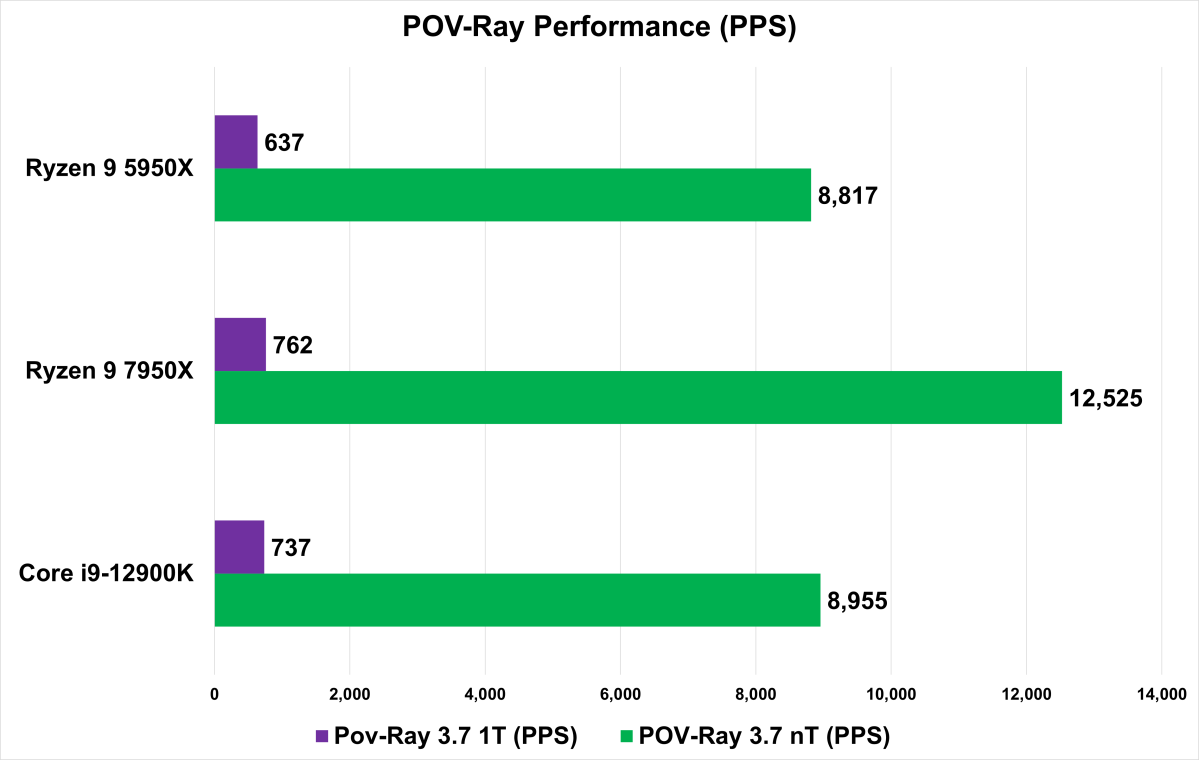
Gordon Mah Ung / PCWorld

Gordon Mah Ung / PCWorld
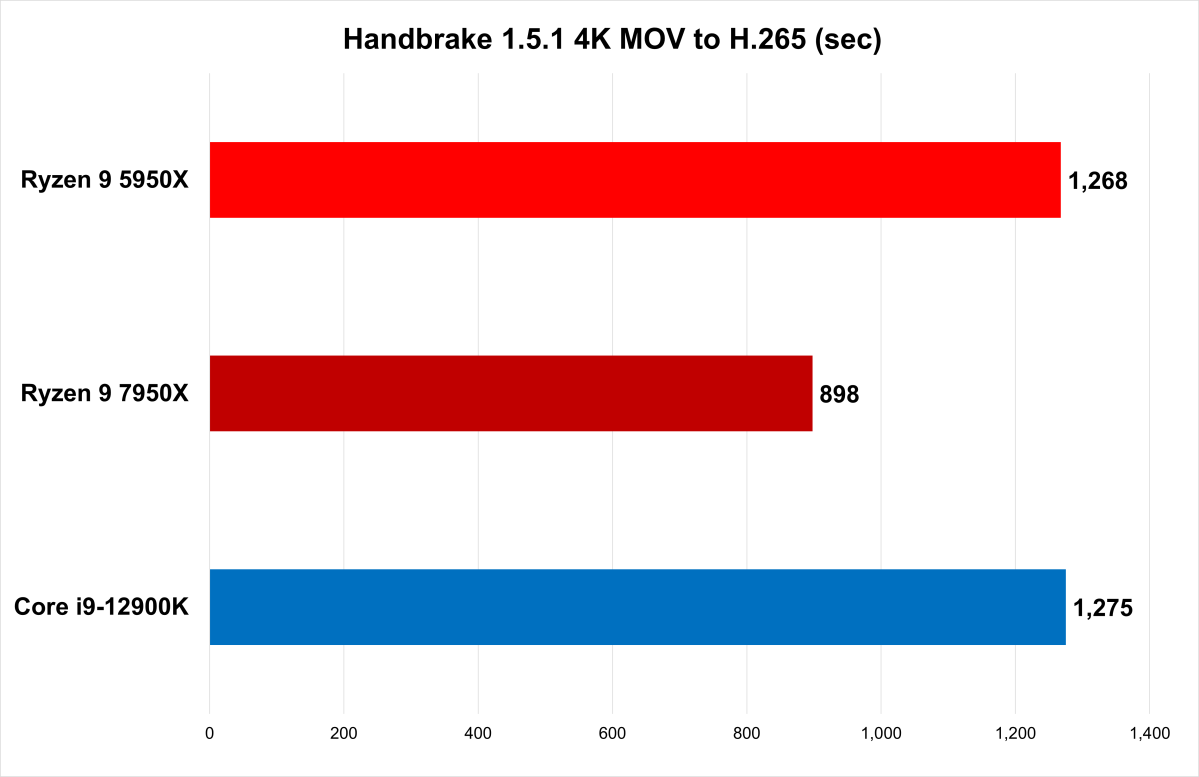
Gordon Mah Ung / PCWorld
When rendering and encoding, the Ryzen 9 7950X whomps on the Core i9-12900K, with a comfortable, chunky double-digit lead across our multithreaded benchmarks. How comfortable? As much as 60 percent. The smallest win hits the books at 37 percent. The 7950X also leaves the Ryzen 9 5950X eating its dust, with the gains reaching as high as 48 percent.

Gordon Mah Ung / PCWorld

Longer bars indicate better performance.
Gordon Mah Ung / PCWorld

Blue represents better Intel performance. Red bars indicate better AMD performance.
Gordon Mah Ung / PCWorld
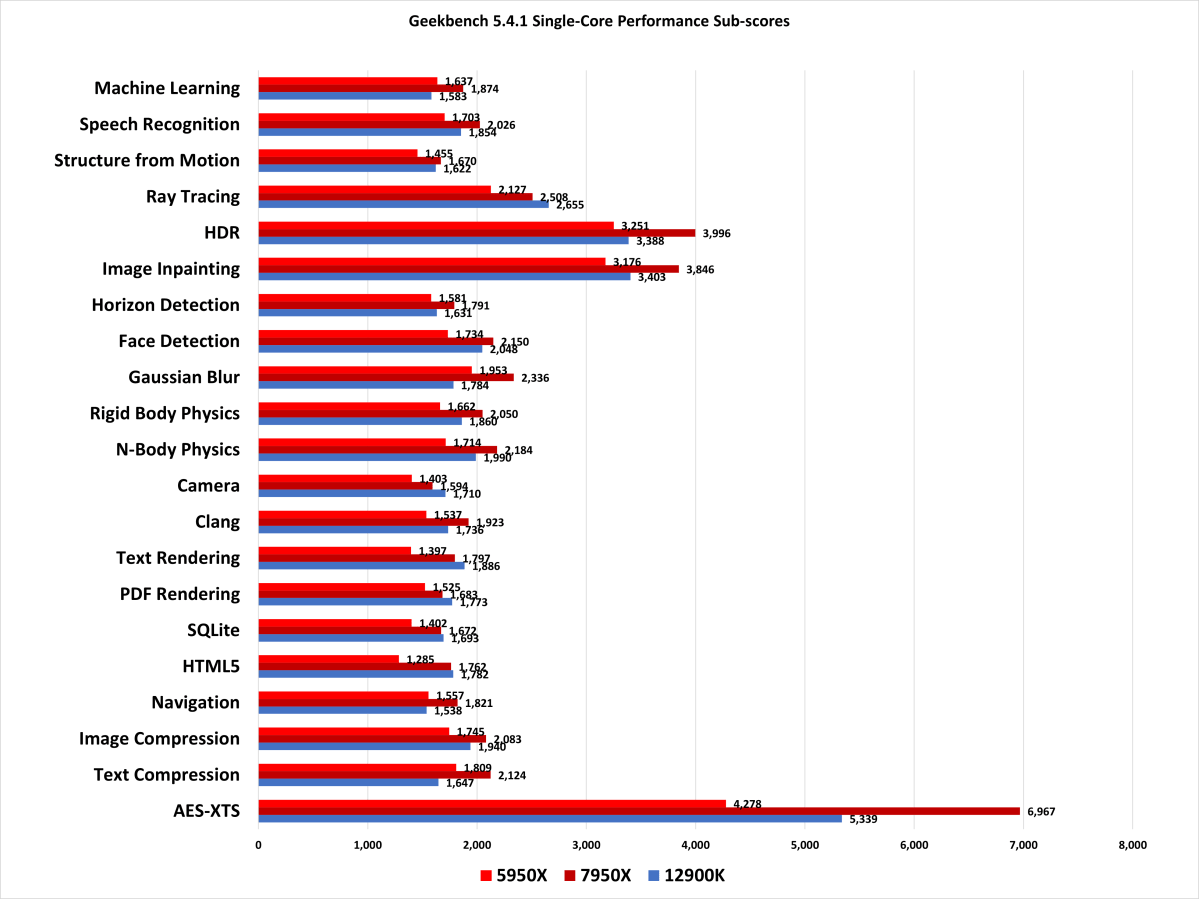
Longer bars indicate better performance.
Gordon Mah Ung / PCWorld
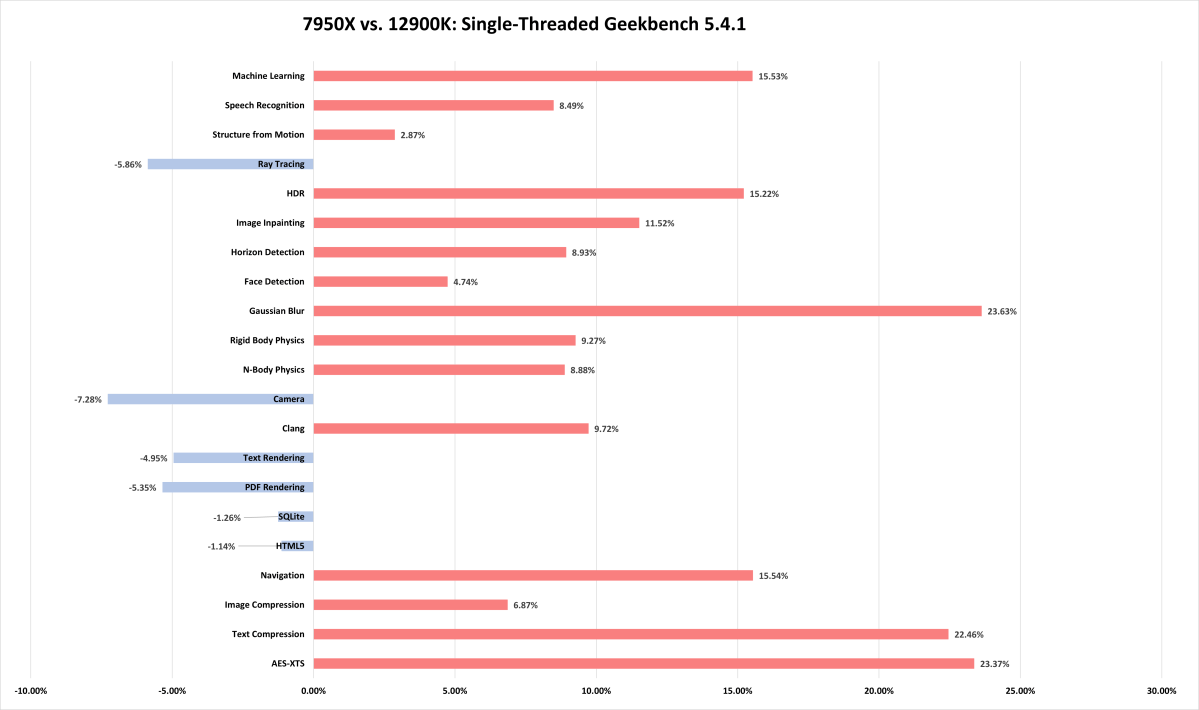
Blue represents better Intel performance. Red bars indicate better AMD performance.
Gordon Mah Ung / PCWorld
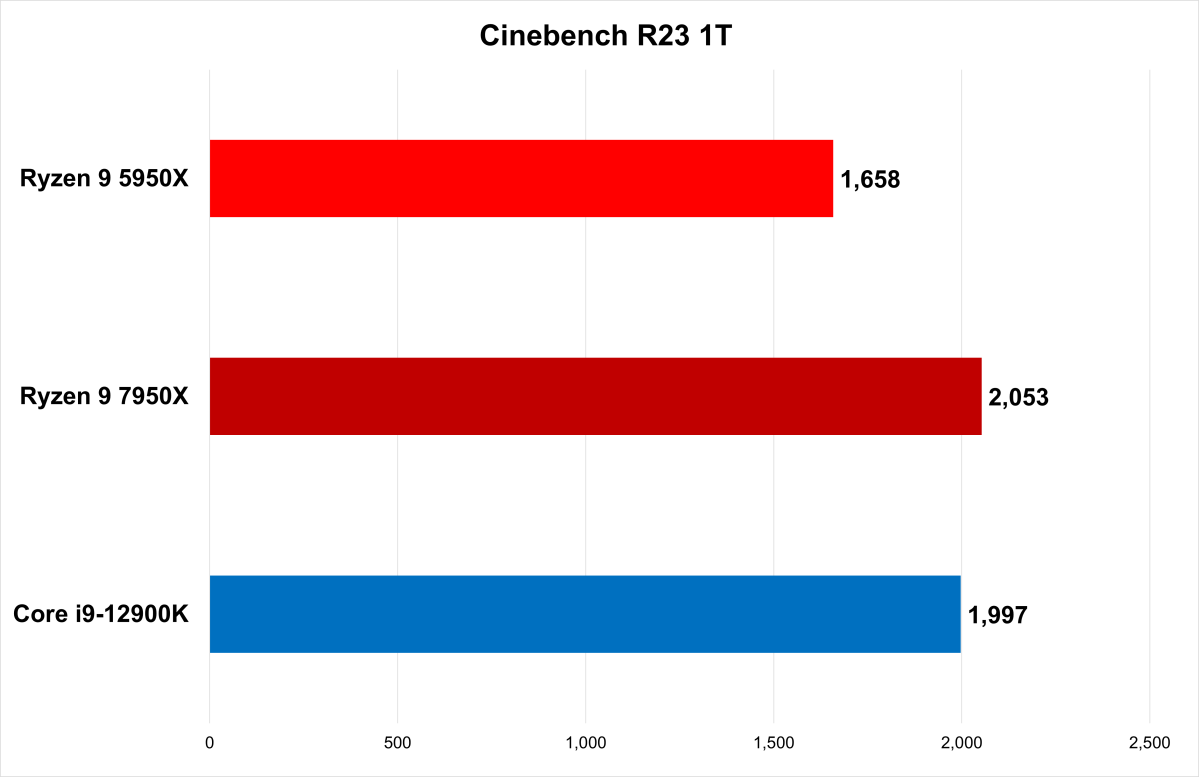
Longer bars indicate better performance.
Gordon Mah Ung / PCWorld
But AMD’s new top chip isn’t completely invulnerable to the 12900K. The subscores of tests like Geekbench indicate areas where Intel might still retain an advantage. (For example, machine learning and encryption.) Also, peek at the difference in single-core performance and you’ll see the 12900K holding its own. It cedes the top spot to the 7950X by a slim margin of just a few percentage points in our rendering tests.
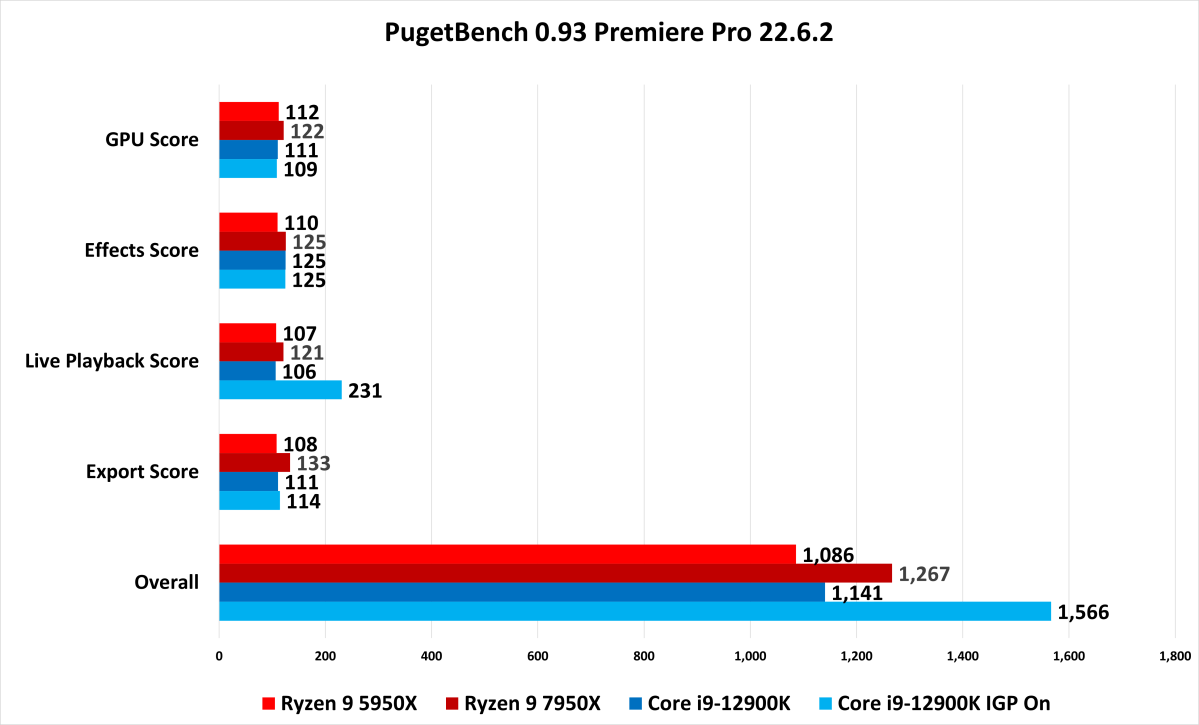
Longer bars indicate better performance.
Gordon Mah Ung / PCWorld
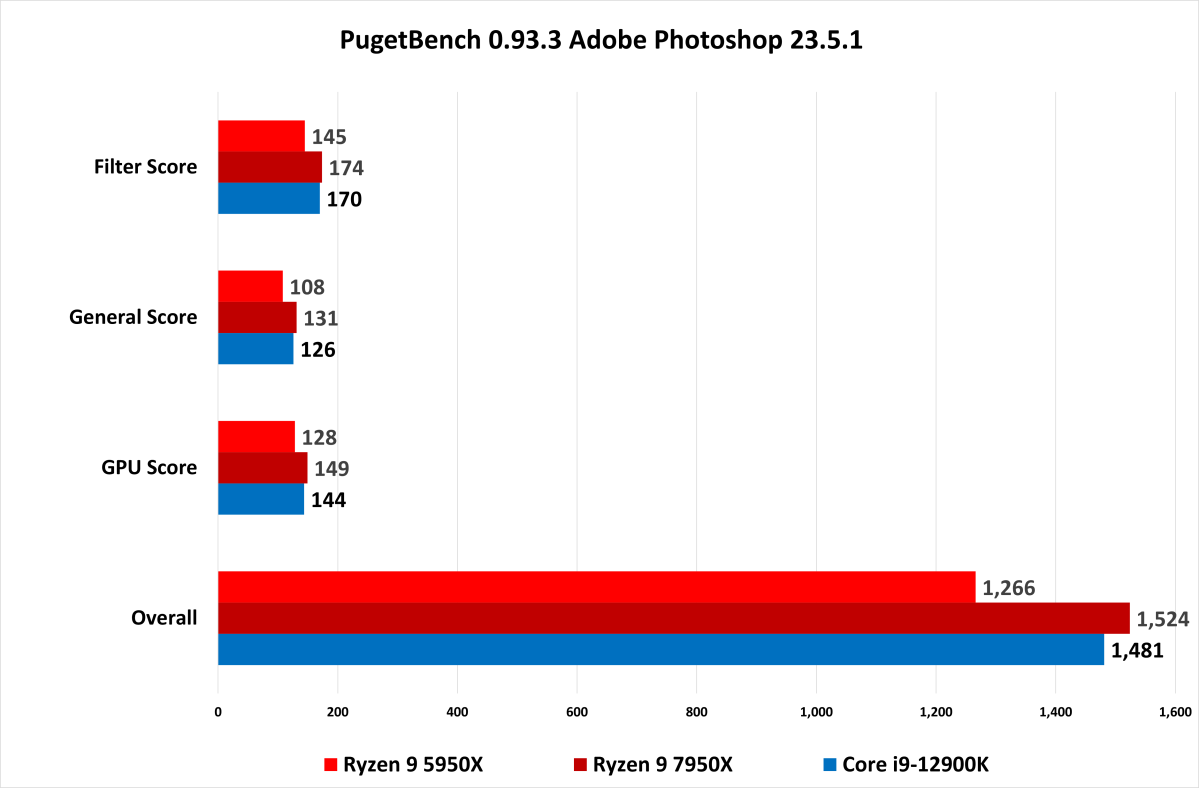
Longer bars indicate better performance.
Gordon Mah Ung / PCWorld

Longer bars indicate better performance.
Gordon Mah Ung / PCWorld
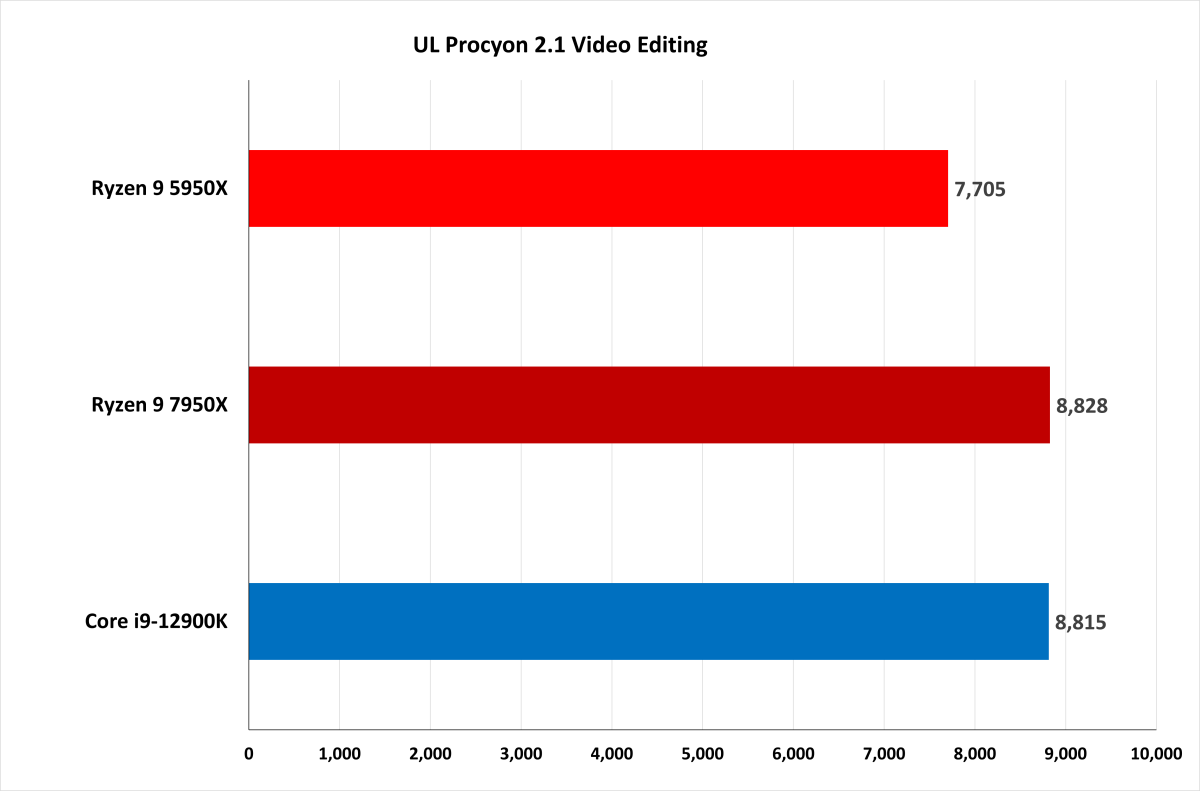
Longer bars indicate better performance.
Gordon Mah Ung / PCWorld
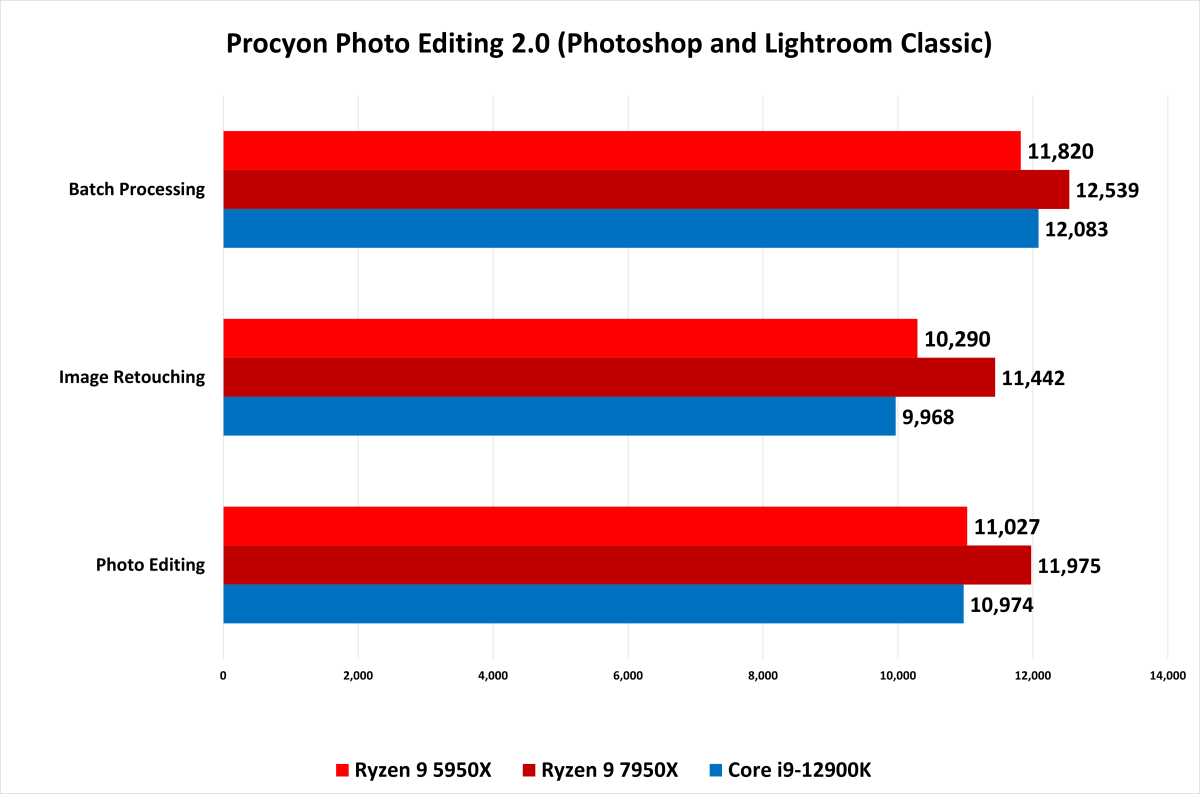
Longer bars indicate better performance.
Gordon Mah Ung / PCWorld
That small difference in performance, plus software optimizations, mean that the 12900K—or more likely its upcoming successor, given the rumors about the Core i9-13900K’s imminent launch date—will still be the better choice for some folks. AMD simply can’t win the battle in Adobe Premiere Pro, for example. Premiere’s use of QuickSync to boost video encoding speed gave Intel a nearly 20 percent edge in our PugetBench benchmark results.
That said, not everyone uses Adobe Creative Cloud, nor is willing to give up the AMD ecosystem. If you’re upgrading from a 5950X, you’ll get tangible gains across the board, both for single-core and multithreaded work.
In short, if you’re seeking an absolute beast of a chip, the 7950X can keep your projects steaming full speed ahead—but Intel might be a better option in select applications.
Gaming
Real talk: Unless you have money you want to burn (and actually lighting it on fire is just a little too wasteful), purchasing a Ryzen 9 7950X for gaming alone is impractical. But gaming is still a popular way to evaluate chips, especially since flagship chip owners sometimes play after work is over.
In the battle between the 7950X and the 12900K, the wins largely went to the 12900K, with the overall average of our nine 1080p benchmarks showing AMD underperforming Intel by about 1.5 percent. With single-core performance still important for many games, this outcome isn’t a surprise—the 7950X’s results here are similar to our other single-core benchmarks. But in real-world terms, this loss is a fairly minimal one. You’re generally looking at a difference of 3 to 12 frames per second at already high frame rates.
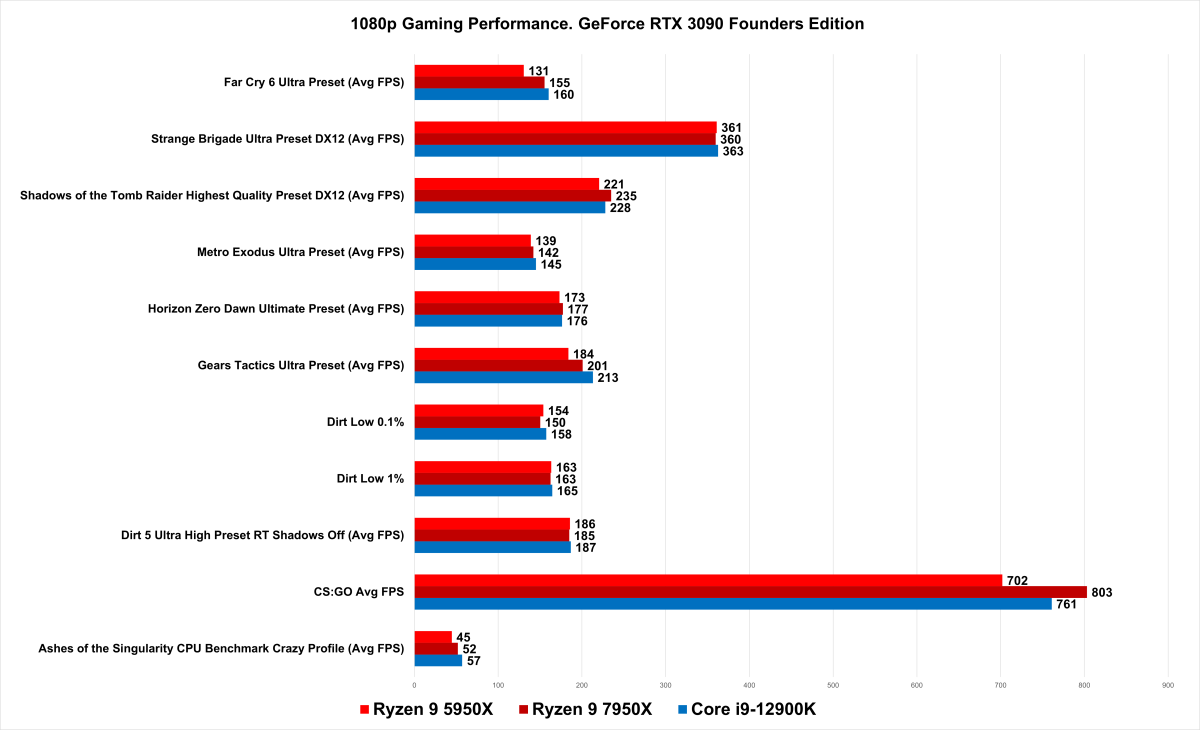
Longer bars indicate better performance.
Gordon Mah Ung / PCWorld
But what about 720p benchmarks, you say? We chose to focus on 1080p benchmarks for practical reasons—a PC with a 7950X typically runs games at 1080p or higher. But if you must know what happens when further isolating CPU performance, you can get an idea of Ryzen 7000’s behavior at 720p through our sister site PC Welt’s test results, which examines how the lower-cost Ryzen 9 7900X and Ryzen 5 7600X compare against a variety of competing chips.
(Caveat: This data can’t be directly compared with the gaming benchmarks above, due to key component differences between PCWorld and PC Welt’s test machines. Different CPU, GPU, memory speed, and operating systems were used for testing [7950X vs 7900X & 7600X; RTX 3090 vs RX 6900 XT; DDR5-6000 vs DDR5-5200; Windows 11 vs 10].)
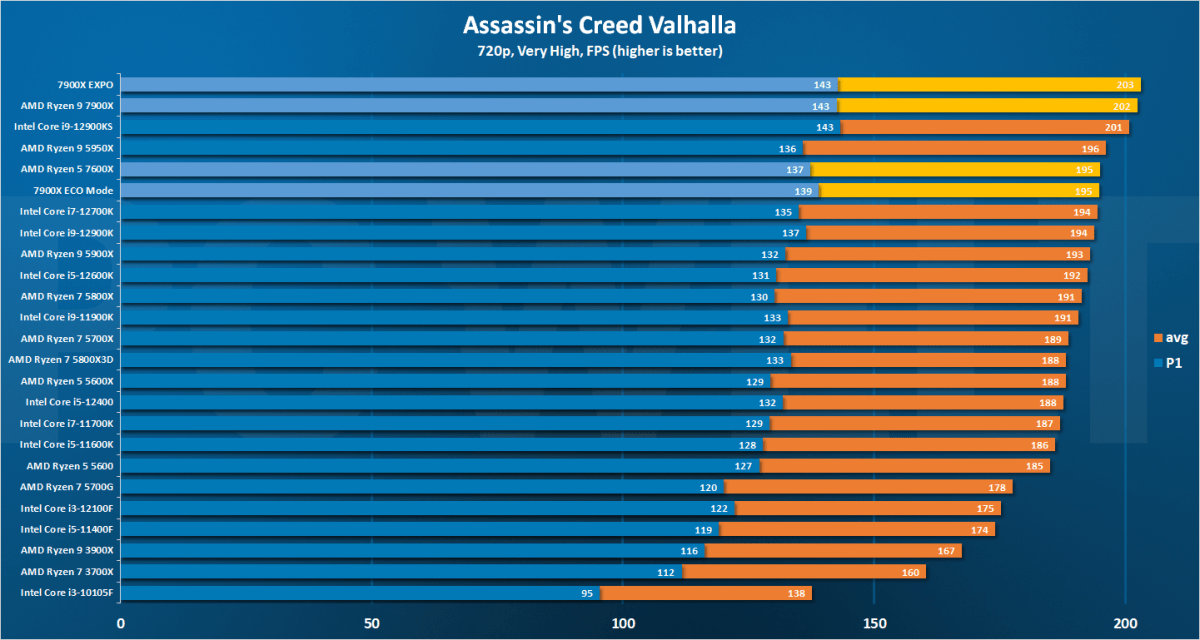
Longer bars indicate better performance.
PC Welt
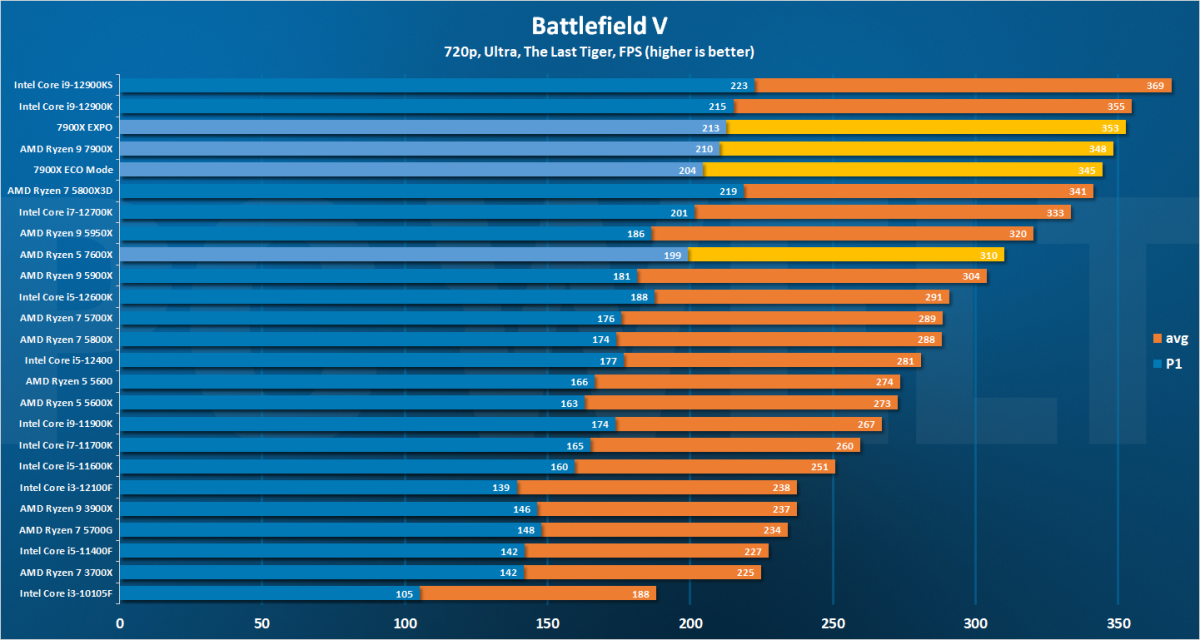
Longer bars indicate better performance.
PC Welt
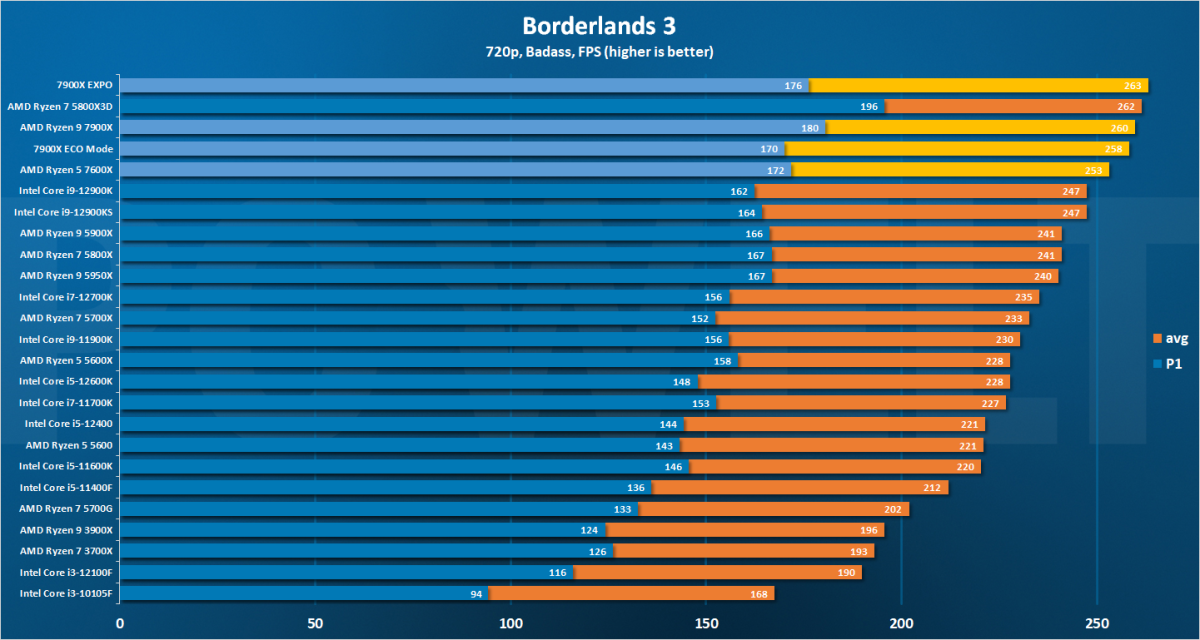
Longer bars indicate better performance.
PC Welt
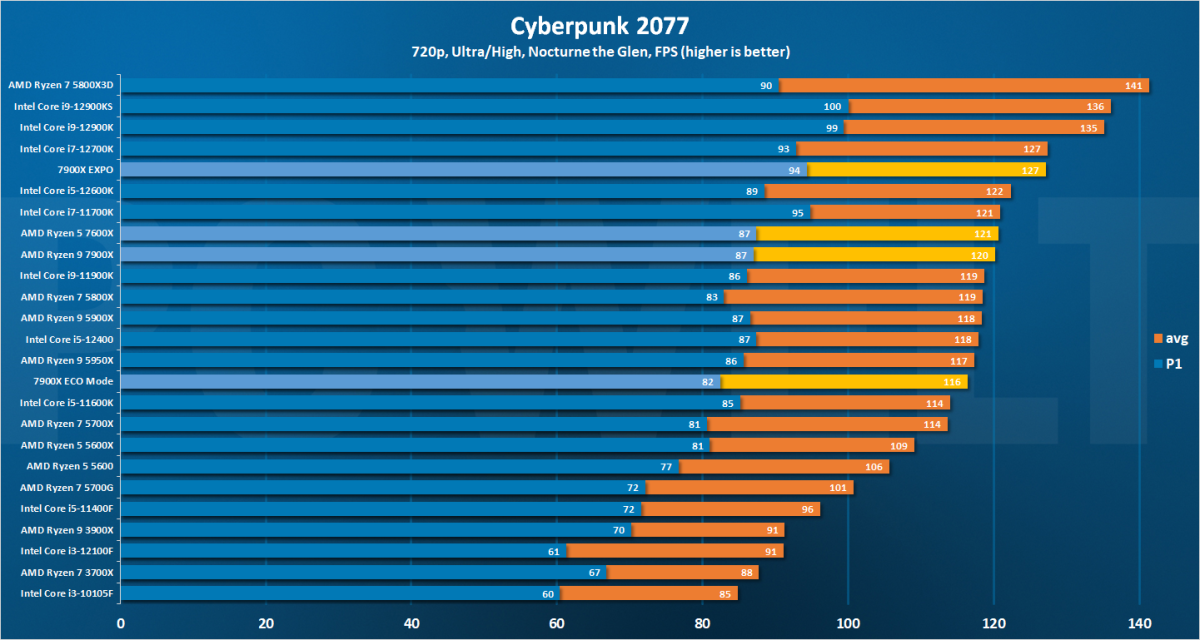
Longer bars indicate better performance.
PC Welt

Longer bars indicate better performance.
PC Welt

Longer bars indicate better performance.
PC Welt

Longer bars indicate better performance.
PC Welt
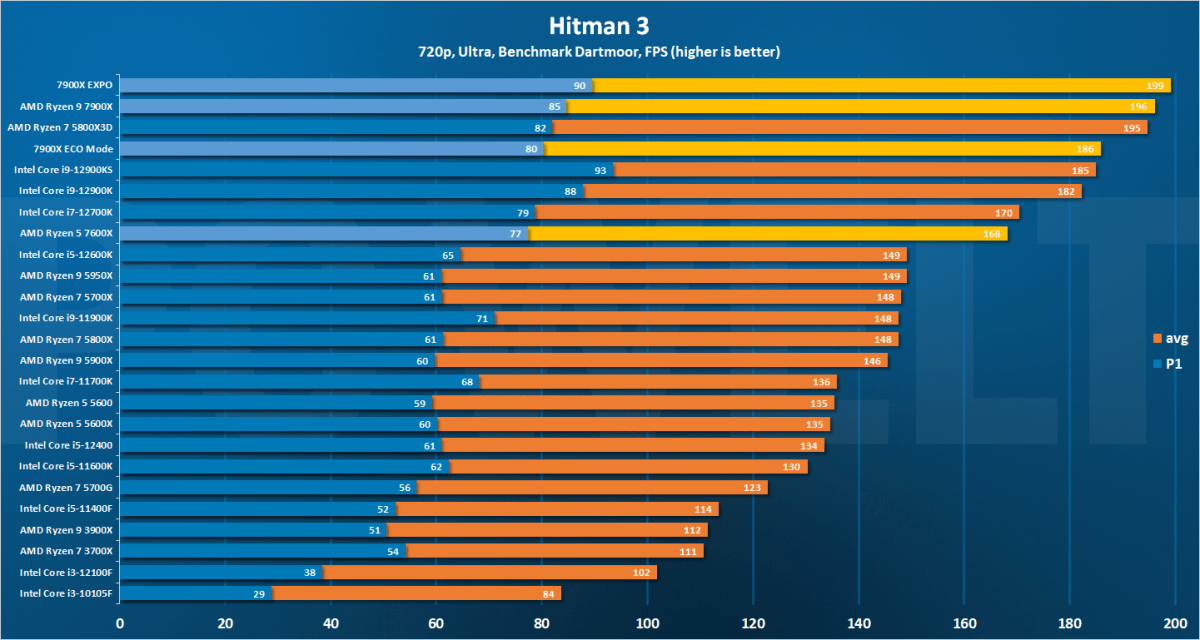
Longer bars indicate better performance.
PC Welt
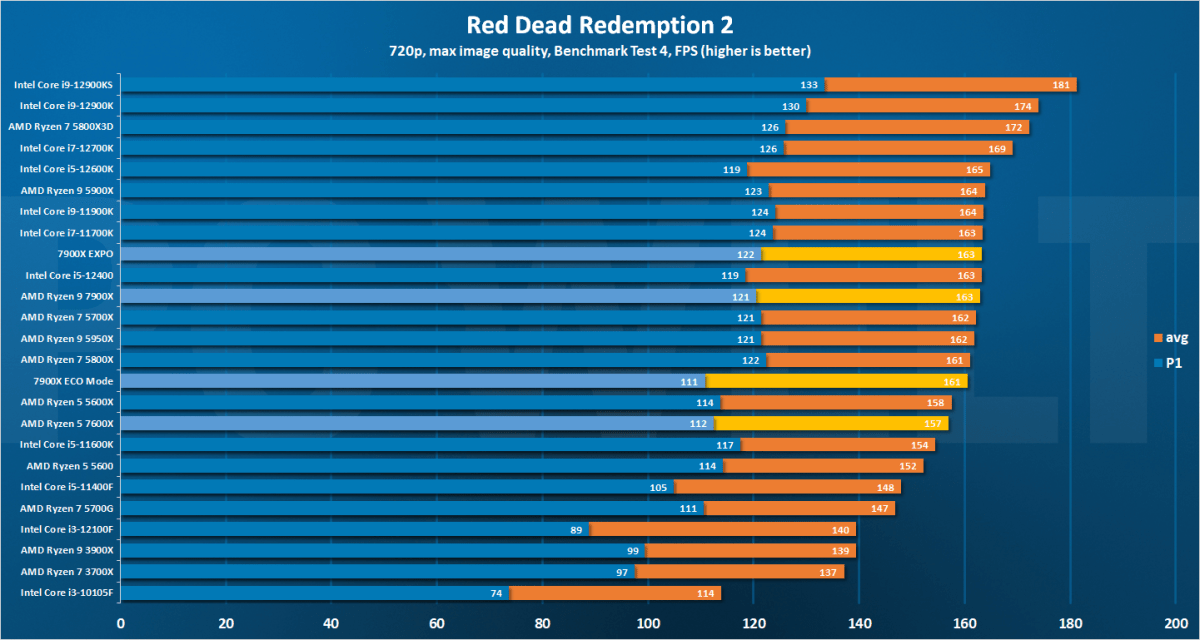
Longer bars indicate better performance.
PC Welt
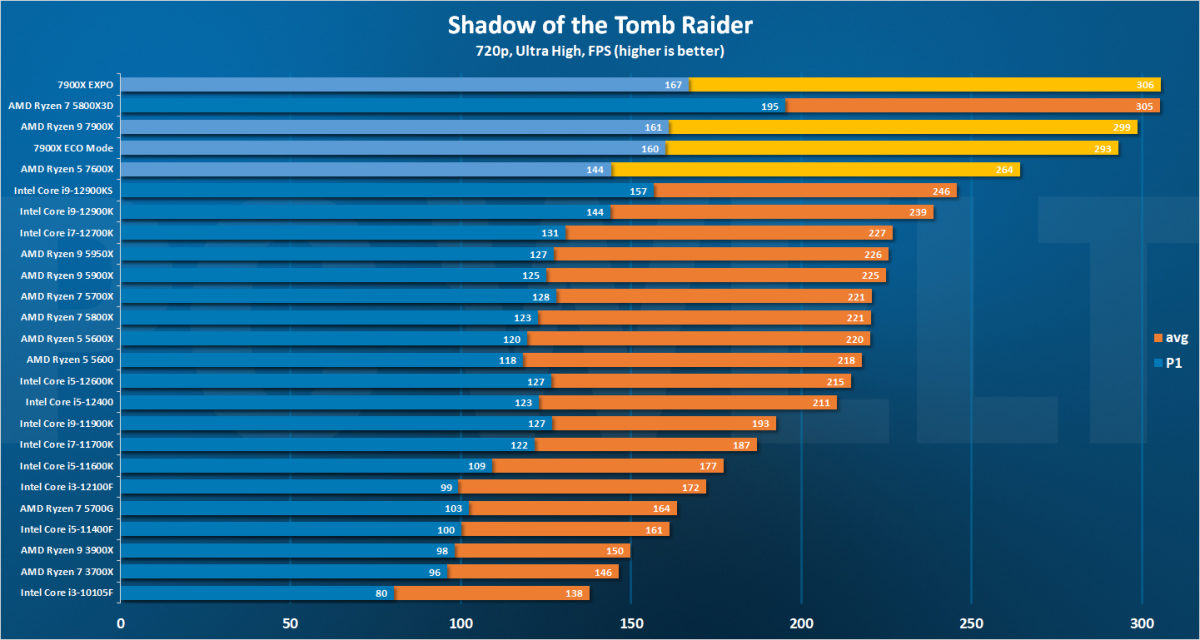
Longer bars indicate better performance.
PC Welt

Longer bars indicate better performance.
PC Welt
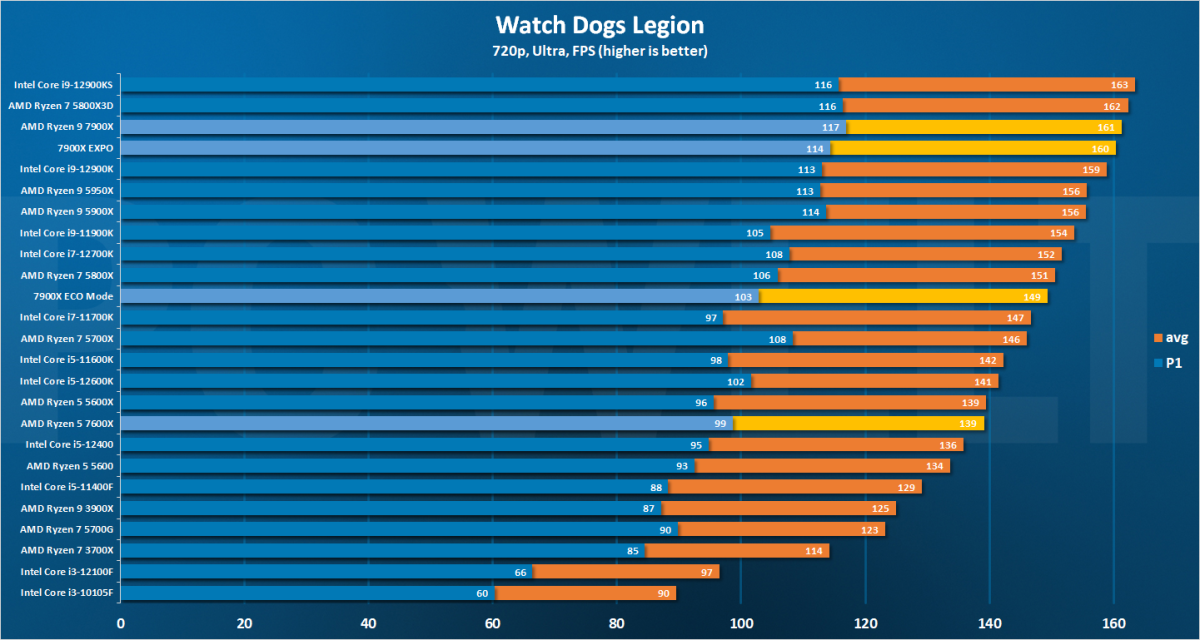
Longer bars indicate better performance.
PC Welt
When you drop down to 720p, AMD’s latest chips trades blows with Intel’s flagship processor—in fact, the 7900X, not the 7950X, is the one that frequently tops the Core i9-12900K in PC Welt’s game benchmarks. When averaged out, AMD’s second-best chip takes the lead by 4.4 percent. Keep in mind, though, individual 720p game results vary and sometimes by a sizable amount. For example, the 7900X beat the 12900K by 25 percent in Shadow of the Tomb Raider, while in Watch Dogs Legion, it’s a scant 1.51 percent difference.
As for gen-on-gen improvement, the 7950X outpaces by 5950X at 1080p by as much as 16 percent, though in a handful of games, it’s roughly a draw. At 720p, PC Welt’s data shows the 7900X pulling ahead of the 5950X by an average of 12 percent. Overall, individual benchmarks vary—so your individual experience will vary, too.
Real-world tasks
When new chips are announced, people rarely talk about how fast they’re going to be in Microsoft Office apps or browsers like Chrome. But those apps are everyone’s daily life blood, and when it comes to number crunching in particular, some people’s full livelihoods. Performance gains matter here, too.

Longer bars indicate better performance.
Gordon Mah Ung / PCWorld
The quick version is that for Microsoft Office apps, the 7950X offers a decent bump in performance versus the 12900K—an average of almost 10 percent. You’ll see double-digit gains for Excel and PowerPoint, while Outlook posts a minimal 2 percent lead. The outcome is more exciting in the showdown with the 5950X; the increase in performance averages over 20 percent, with as much as a 42 percent jump for Word.
(Note for folks who regularly sling huge sets of data: Our hard-hitting Excel eSports benchmark didn’t work properly during our tests, so unfortunately we lack our usual data for chip performance in heavy spreadsheets.)
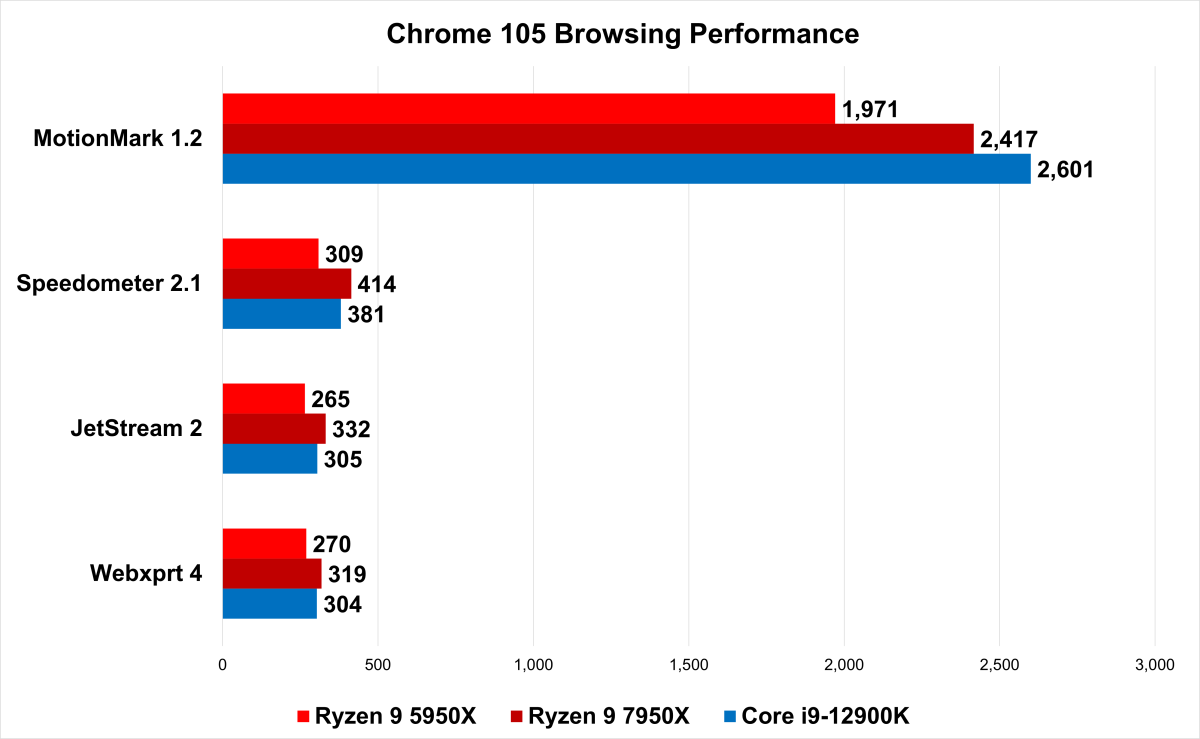
Gordon Mah Ung / PCWorld
As for web browsing, the 7950X is generally the fastest chip, though Intel is better at rendering in Chrome (aka graphics performance). For tasks related to Javascript, HTML, web apps, and more, the 7950X comes out ahead—more modestly against the 12900K, but by a sizable amount compared to the 5950X. Compared to the latter, the 7950X posts double-digit improvements that reach as high as 33 percent.
Power draw & Eco mode
Discussing power draw used to be more of an academic exercise. You’d test to see who had better efficiency and to get a general idea of power consumption, but typically the results weren’t of large concern.
In just the last couple of years, that’s changed. As mentioned earlier, chips have started to consume more power. Ryzen 7000 joins that trend. While the Ryzen 9 5950X and 5900X had TDP ratings of 105W, the Ryzen 9 7950X and 7900X now enter the lists at 170W.
TDP ratings have also become a baseline for power usage under load, rather than an expected maximum. Today’s chips have much more variability and can pull down considerably more electricity while chasing higher performance. For the Core i9-12900K, that works out to a base of 125W and a peak of 241W. The 170W Ryzen 9 7950X’s max is its socket power rating, or 230W.
Combine this higher power consumption with rising electricity rates, and both power draw and power efficiency are no longer intellectual concerns. Benchmarks spell out how hard a chip will hit your bank account each month.

Gordon Mah Ung / PCWorld
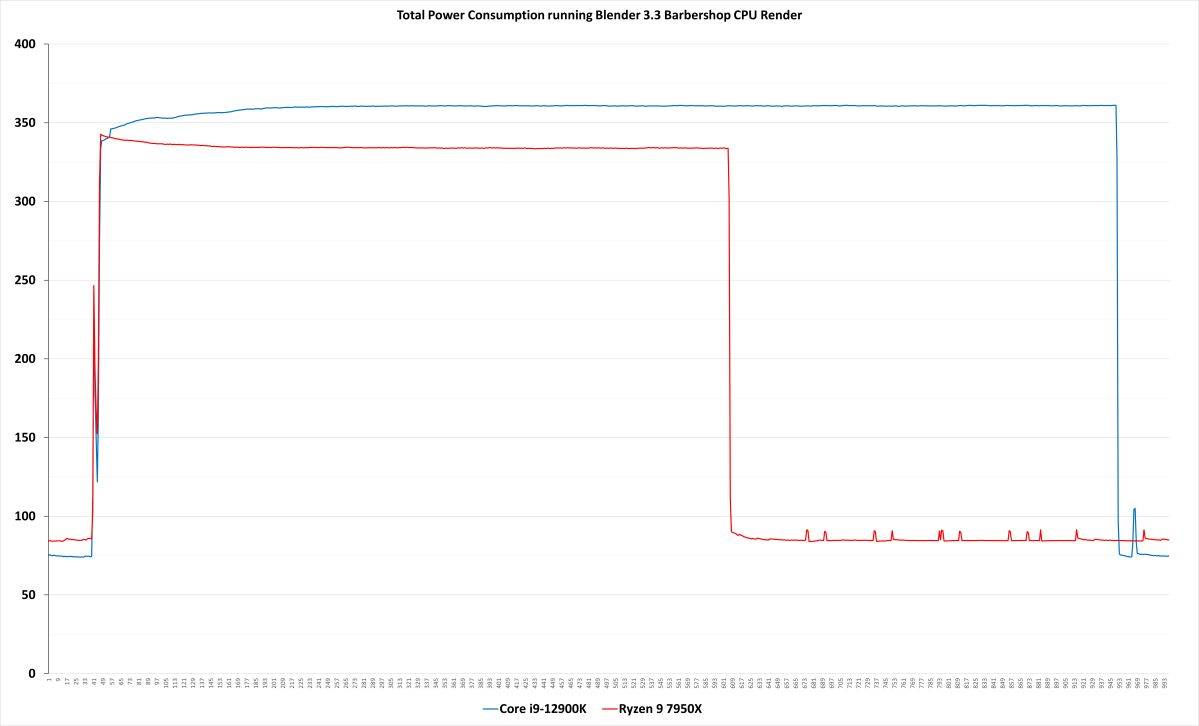
Gordon Mah Ung / PCWorld
The good news is that Ryzen 7000 lives up to AMD’s claims of greater power efficiency in multithreaded tasks—that is, the ability to squeeze more performance from each watt used. It’s also more energy efficient, too, as you can see in our first batch of power draw benchmarks. The 7950X renders about 33 percent more frames than the 12900K in Cinebench R23’s 10-minute multithreaded benchmark. And it does so while consuming about 25W less in total system power than the 12900K throughout.
The Blender benchmark expresses this advantage in a different way—when not tied to a fixed-length benchmark, the 7950X simply finishes faster, dropping the system down to lower electricity consumption for longer periods.

Gordon Mah Ung / PCWorld

Gordon Mah Ung / PCWorld

Gordon Mah Ung / PCWorld
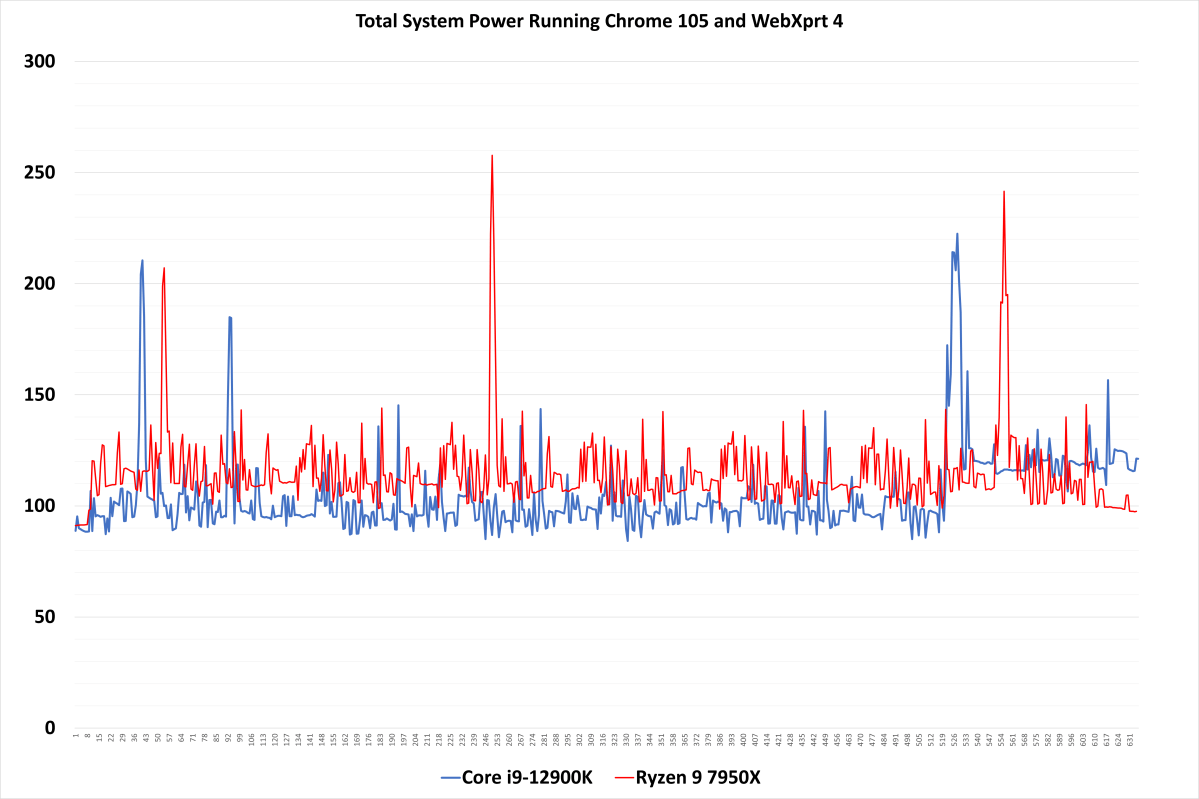
Gordon Mah Ung / PCWorld
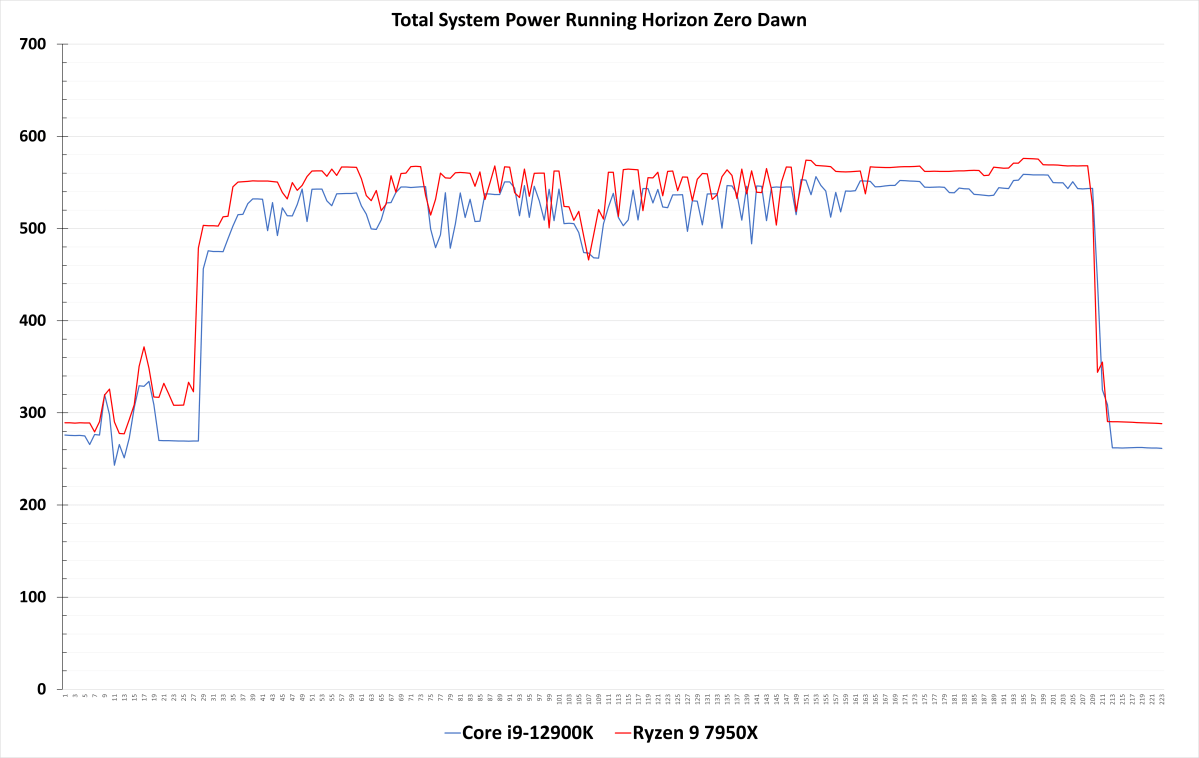
Gordon Mah Ung / PCWorld

Gordon Mah Ung / PCWorld
This clear advantage diminishes as you move into single-threaded and lightly threaded applications. Here, the 12900K generally outperforms the 7950X in energy efficiency—which, when paired with its performance wins in some applications, means that the scorecard could tip in favor of Intel depending on your game purchase and usual software.

Longer bars indicate better performance.
Gordon Mah Ung / PCWorld
Or will it? If you live somewhere that has painfully high electricity rates, AMD’s Eco mode could sway you back toward the 7950X. You might call it AMD’s ace up its sleeve—this setting adds a flourish to its boasts about power efficiency.
It’s a simple, straightforward way to set power limits on a chip; no need to go into the BIOS. Via AMD’s Ryzen Master software, you can drop a 170W chip down to 105W or 65W, with a fairly minimal hit to performance in single-core and lightly threaded tasks. Just take a look at the Cinebench R23 single-core results for our 7950X. Its score stayed all but locked in the same spot, even as we dropped the TDP from to 105W and then even further to 65W.
For additional context, you can hop back to PC Welt’s gaming tests. The 7900X and 7900X Eco mode results are typically within a percent or so of each other at 1080p; the gap widens by only a few more percentage points at 720p. (Note: the 7900X was dropped to 65W for PC Welt’s benchmarks.) At both resolutions, the winner per game see-sawed between the stock profile and Eco mode.
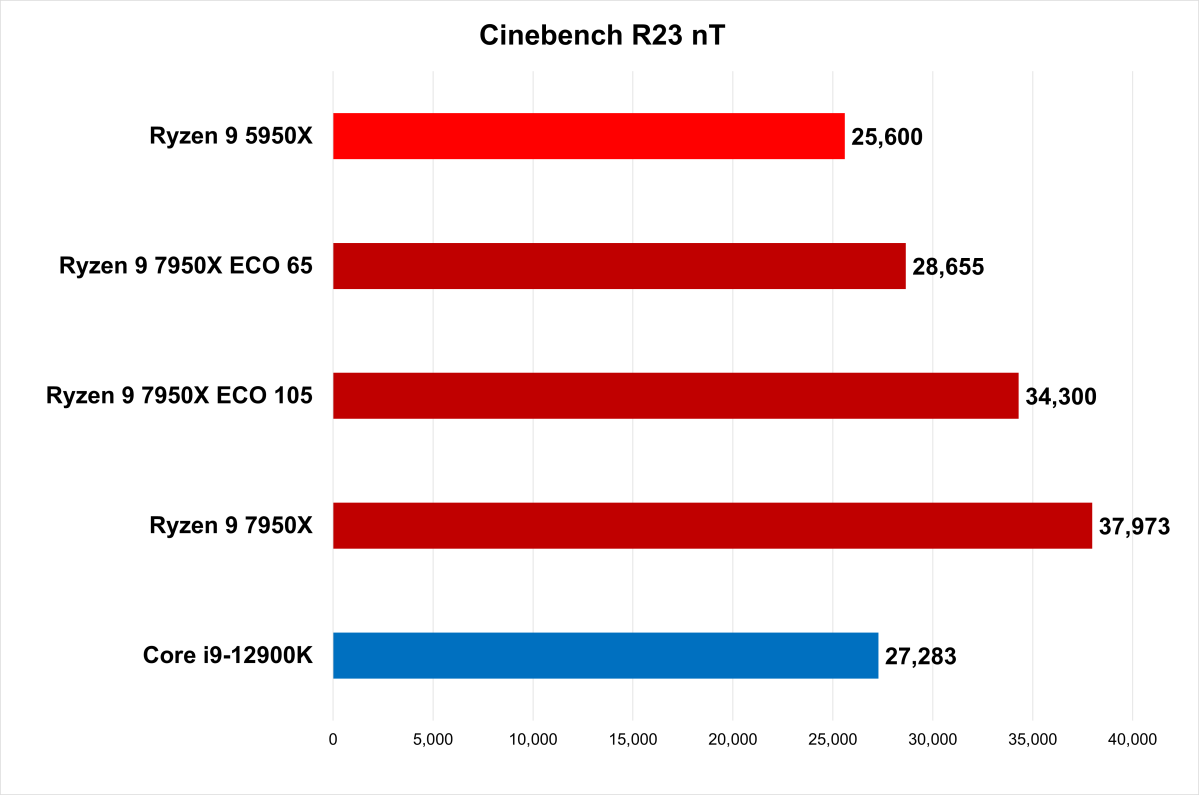
Gordon Mah Ung / PCWorld
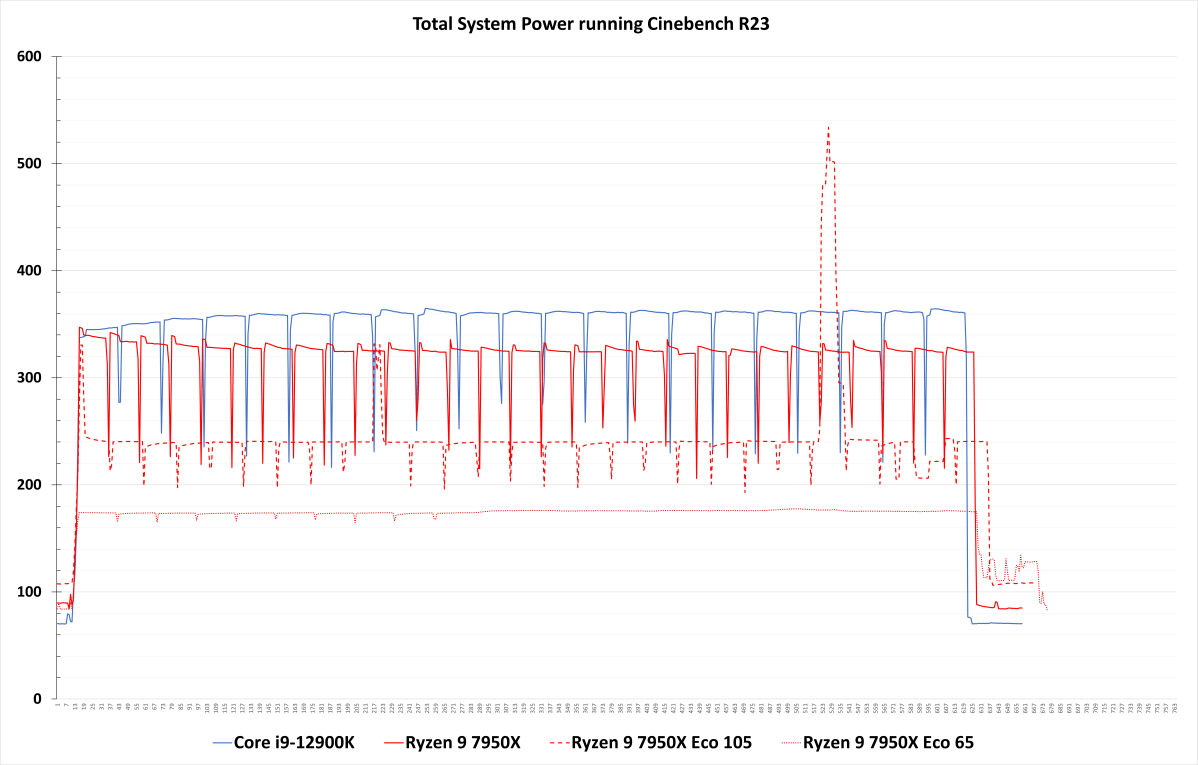
Gordon Mah Ung / PCWorld
Of course, Eco mode does hamper performance in multithreaded tasks, but that’s no surprise—you need the additional power to let the chip run at full capacity. But the option is there, in case you need to keep a tight leash on power draw.
Final thoughts
The Ryzen 9 7950X is an impressive start to the AM5 era. Zen 4 offers significant, tangible performance benefits for multithreaded tasks and power efficiency, and it’s backed by AM5’s bleeding-edge speeds for other system components. If you make full use of what the 7950X brings to the table, you can’t go wrong. To emphasize the point, just look at how its relative performance scales against the Core i9-12900K and last-gen Ryzen 9 5950X as you involve more and more threads.

Gordon Mah Ung / PCWorld
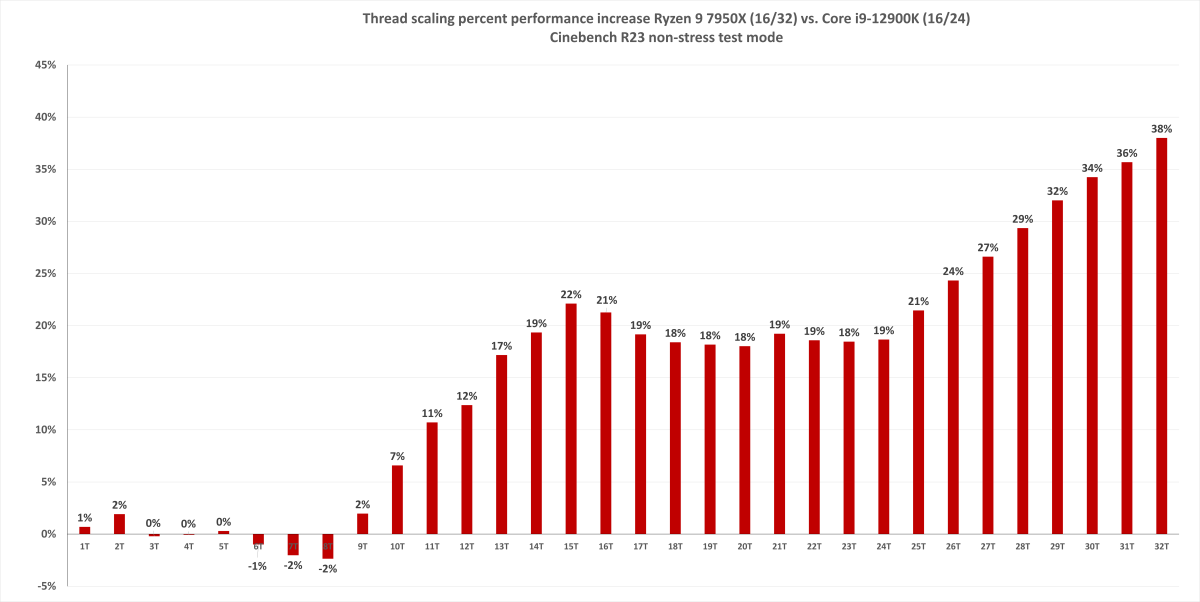
Gordon Mah Ung / PCWorld
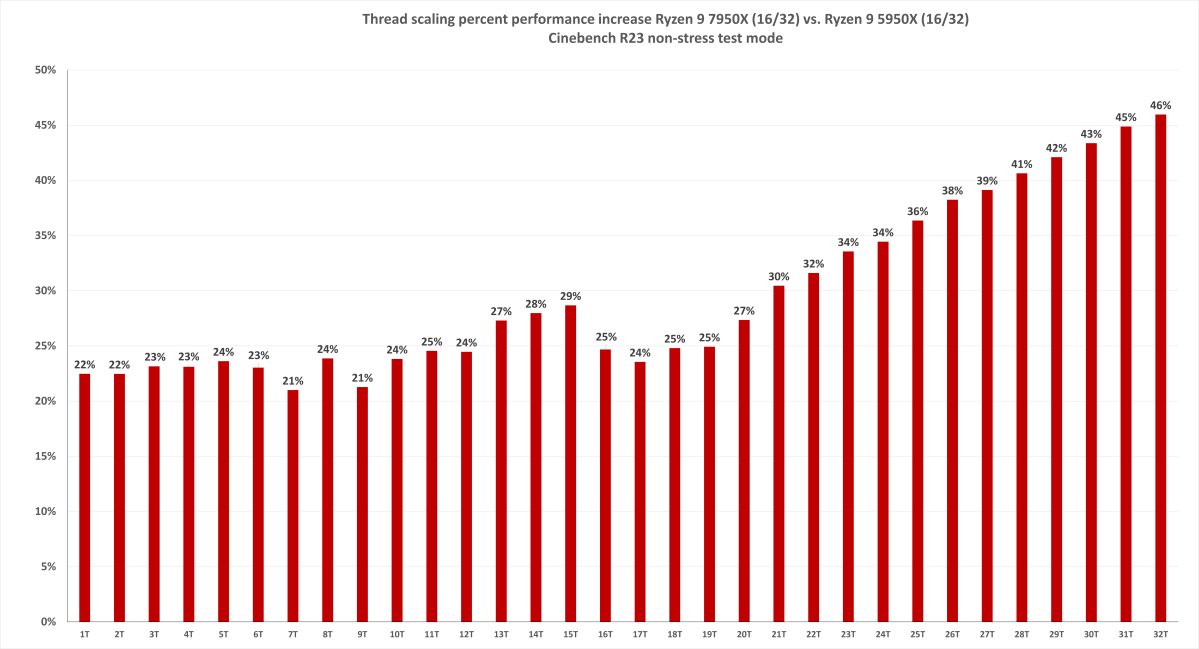
Gordon Mah Ung / PCWorld
At the same time, Ryzen 7000 stands on unstable ground. Its spot in the winner’s circle isn’t as secure as when Ryzen 5000 launched. It must contend with both Intel 12th-generation chips and the near-term prospect of 13th-gen Raptor Lake, too. In fact, Intel may spill the beans about Raptor Lake at its Intel Innovation 2022 event on September 27th, the very date that Ryzen 7000 hits streets. That realistically gives 7950X and its siblings but a day of focused attention in the spotlight.
But don’t read the situation as bleak for AMD. Ryzen 7000’s launch is more like the opening to a revamped theater show: Before AMD and Intel took clear turns, with long pauses between each act. Now the story’s getting complex, with faster pacing, an intricate plot, more actors on stage, and constant action in the background.
So sure, Intel has teased gen-on-gen improvements of 15 percent for single-threaded performance and a whopping 41 percent increase for multithreaded. But the rumors also suggest Intel’s Raptor Lake chips can shoot past 300W for power consumption while boosting—not a surprise, given the claims of 6GHz clock speeds. And that could end up problematic for Team Blue.

PCWorld
One of the greatest things AMD did for the PC was taking high-octane computing and put it into the hands of the masses. Before Ryzen launched, an 10-core, 20-thread processor cost a painful $1,723; an 8-core, 16-thread processor came in at just under $1,110. Team Red put the stuff of dreams (and server rooms) into hands of consumers. AMD is the reason we now take processors with more than four cores for granted.
With electricity rapidly becoming more expensive worldwide, high-wattage parts—even ones that boast insane specs—start to float back up into the stratosphere. Power bills are rising, with some reports out of Europe indicating dramatic price jumps or anticipation of coming ones. CPUs may no longer be as affordable they once were (particularly at the high-end) thanks to secondary costs.
And so AMD’s focus on power efficiency could end up being the next important fight with Intel. But how that plays out—and where that plays out, given the popularity of laptops—remains to be seen. It’ll be revealed in time, during the next acts of the AMD vs Intel show. In the meantime we’re going to have plenty to discuss at the next intermission, and it’s coming in a little over 24 hours. No matter how the battle turns out, the Ryzen 9 7950X stands as a ferocious start to AMD’s next chapter.
For all the latest Technology News Click Here
For the latest news and updates, follow us on Google News.
